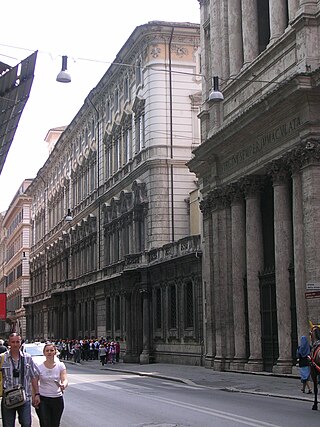
The Doria Pamphilj Gallery is a large private art collection housed in the Palazzo Doria Pamphilj in Rome, Italy, between Via del Corso and Via della Gatta. The principal entrance is on the Via del Corso. The palace façade on Via del Corso is adjacent to a church, Santa Maria in Via Lata. Like the palace, it is still privately owned by the princely Roman family Doria Pamphili. Tours of the state rooms often culminate in concerts of Baroque and Renaissance music, paying tribute to the setting and the masterpieces it contains.

Marquis Giacomo Doria was an Italian naturalist, botanist, herpetologist, and politician.

Doria's goshawk or Doria's hawk, is a raptor, the only member of the genus Megatriorchis.
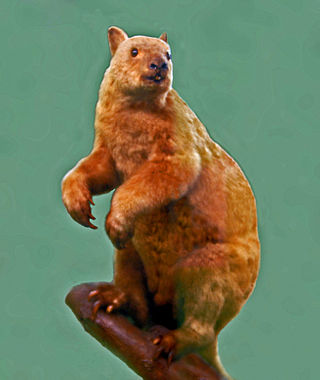
Doria's tree-kangaroo is a long-tailed, furry, bear-like mammal found only in tropical mountain forests on the island of New Guinea. It is one of the largest tree-kangaroos, living alone in trees and active at night to feed on leaves or fruit. It belongs to the macropod family (Macropodidae) with kangaroos, and carries its young in a pouch like other marsupials. Threats include hunting and habitat loss.
The Sumatran mastiff bat is a species of bat in the family Molossidae, the free-tailed bats. It is only known from Sumatra in Indonesia. It was described in 1907 and has not been recorded since.

The Museo Civico di Storia Naturale Giacomo Doria is a natural history museum in Genoa, northern Italy. It is named after the naturalist Giacomo Doria, who was the founder and the curator for over forty years.

Chirixalus doriae, commonly known as Doria's Asian treefrog, Doria's bush frog, Doria's bush frog, and Doria's tree frog, is a species of frog in the family Rhacophoridae. It is found in southeastern Asia, from extreme northeastern India and adjacent Bangladesh to Myanmar, Thailand, Cambodia, Laos, Vietnam, and southern China.

The Biak roundleaf bat or Geelvinck Bay leaf-nosed bat is a species of bat in the family Hipposideridae. It is endemic to the Biak Islands and Cenderawasih Bay area of Papua Province, located in Western New Guinea, Indonesia.
Jacme or Iacme Gril(s) was a Genoese troubadour of the mid-thirteenth century. He wrote two tensos which survive, one with Lanfranc Cigala and another (fragmentary) one with Simon Doria.
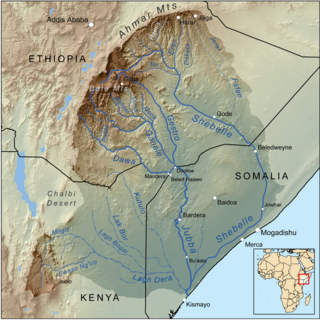
The Ganale Doria River is a perennial river in southeastern Ethiopia. Rising in the mountains east of Aleta Wendo, the Ganale flows south and east to join with the Dawa at the border with Somalia to become the Jubba. The river's tributaries include the Welmel, Weyib, Dumale, Doya, Hawas and the Hambala. The Del Verme Falls is a notable feature of its middle course.

Giovanni Battista Doria (1470–1554) was the 50th Doge of the Republic of Genoa.
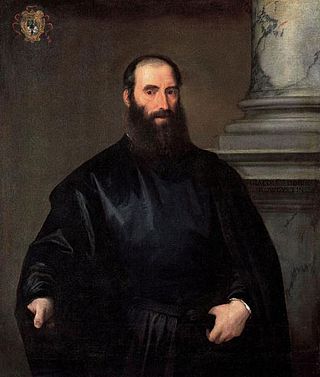
Portrait of Giacomo Doria is a portrait of Giacomo Doria by Titian, painted in 1533–1535 and now in the Ashmolean Museum.
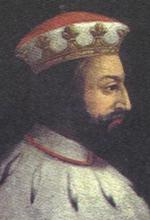
Giorgio Adorno was a statesman who became doge of the Republic of Genoa for two years. His father was Adornino Adorno and his mother Nicolosia della Rocca and his brother, Antoniotto, was elected four times as doge of the Republic. He was born c. 1350 but little is known about his youth except that he married Pietrina Montaldo, daughter of the doge Leonardo Montaldo. With her he had nine children, including the future doge Raffaele Adorno.
Doria or Dória may refer to:
Emilio Berio was an Italian entomologist and lawyer.

The Portrait of Marchesa Brigida Spinola-Doria is an oil-on-canvas painting by Flemish artist Sir Peter Paul Rubens, dating to 1606. It is now in the National Gallery of Art in Washington, D.C., part of the Samuel H. Kress Collection. It was commissioned by Marchese Giacomo Massimiliano Doria of Genoa and shows his wife shortly after their wedding in 1605; she came from the equally prominent Spinola family. He died in 1613 and she remarried another Doria. It has been trimmed several times on each side, removing the garden shown in the background and the lower part of the figure.

Duvalius doriae, the Doria's cave beetle, is a species of beetle belonging to the family Carabidae.

Nicolò Doria was the 72nd Doge of the Republic of Genoa.

Giacomo Grimaldi Durazzo was the 69th Doge of the Republic of Genoa.

Agostino Doria was the 83rd Doge of the Republic of Genoa.















